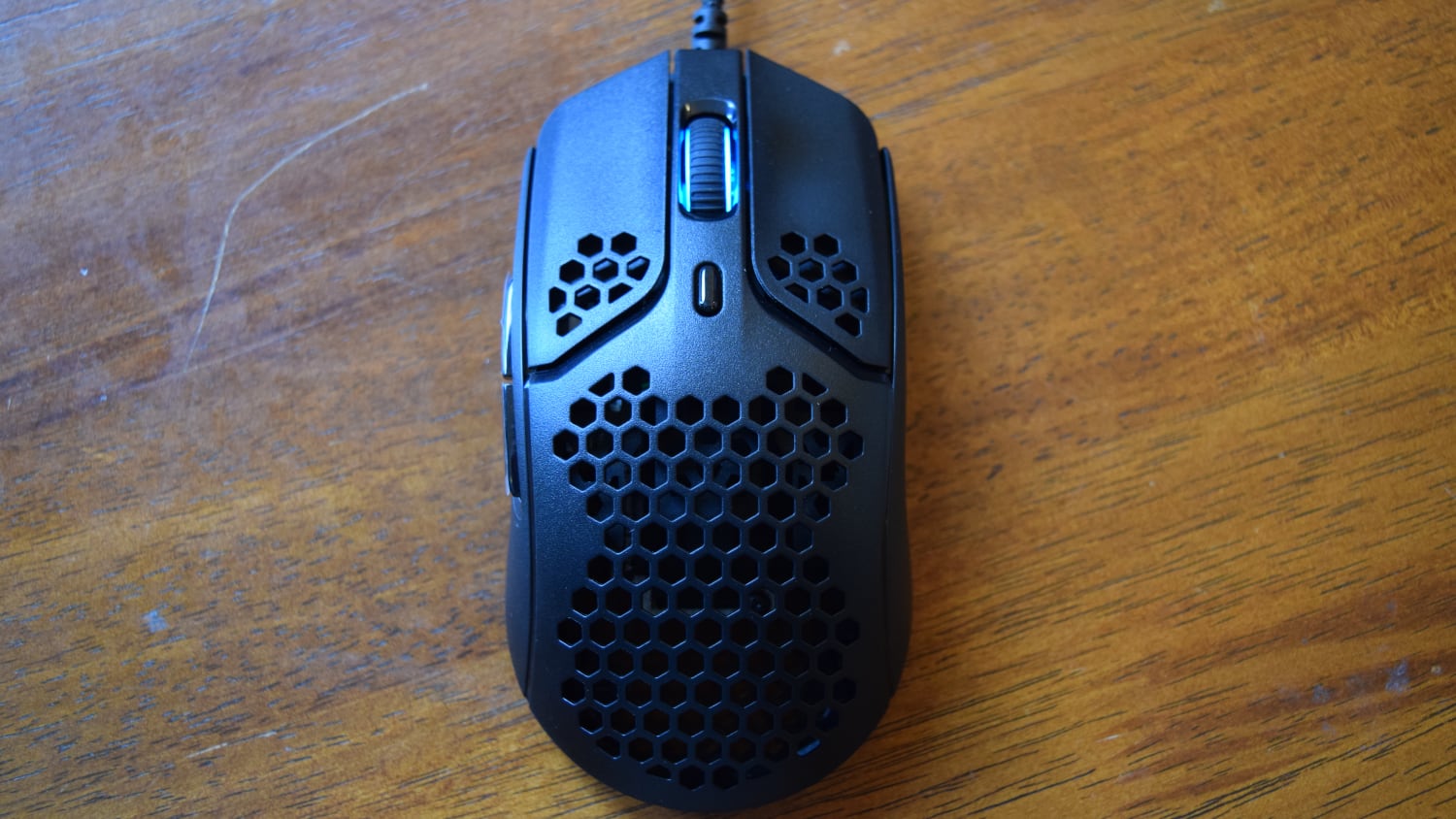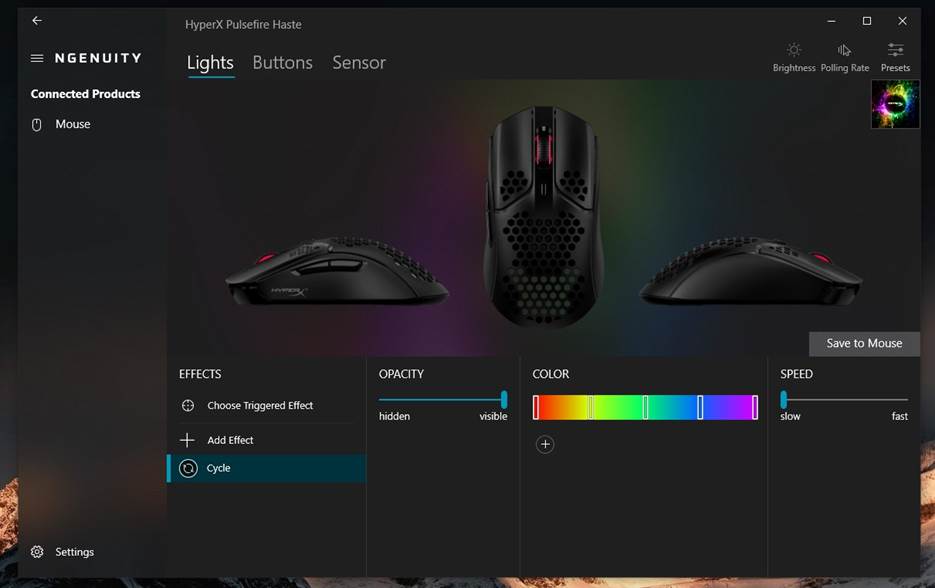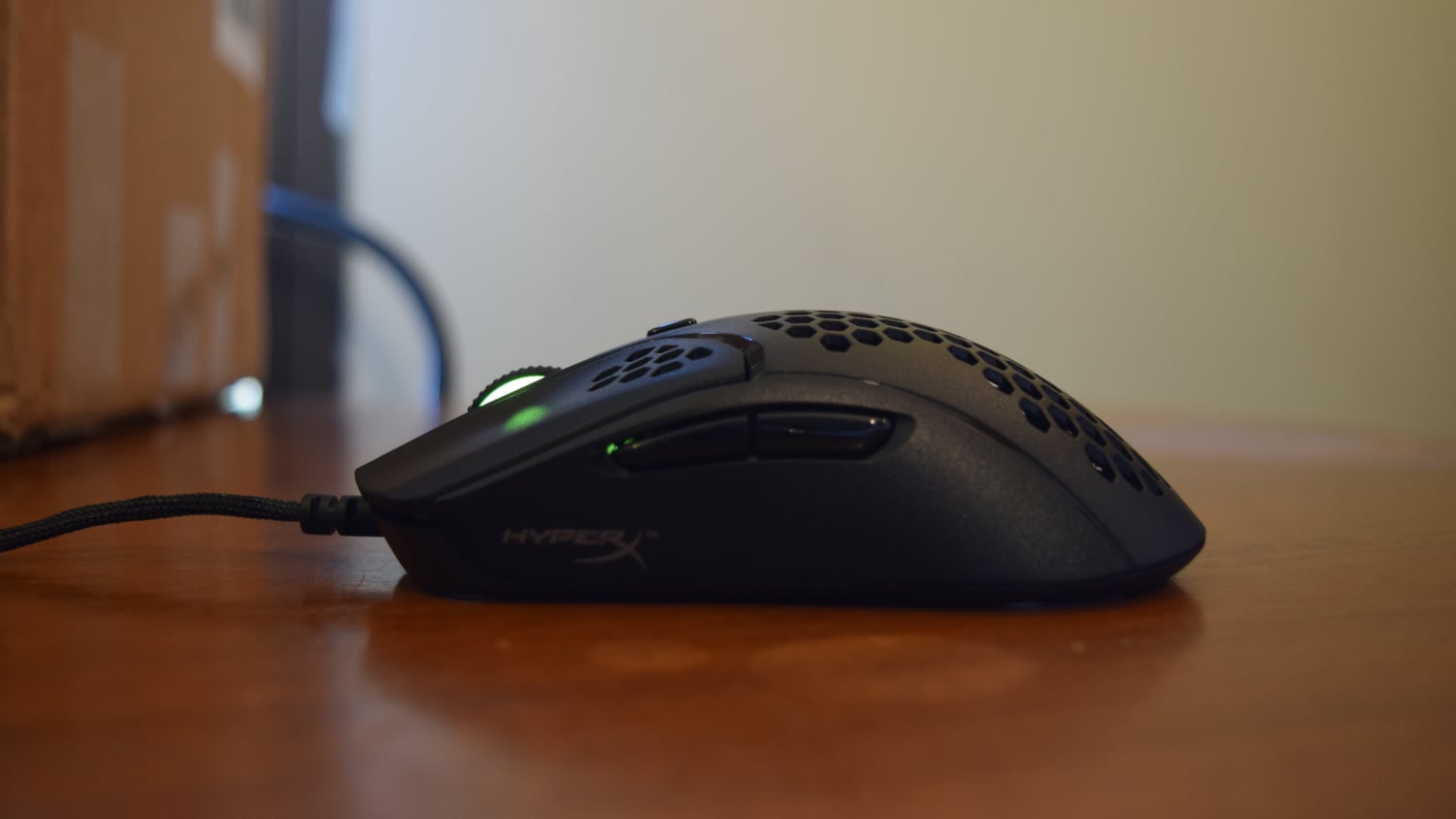Tom's Hardware Verdict
The HyperX Pulsefire Haste is a compelling ultra-lightweight gaming mouse worth considering at its price point. It signals the category’s maturity but doesn’t offer dazzling features or bring anything new to the market.
Pros
- +
Very light
- +
Comes with additional feet and grip tape
- +
Braided USB cable
Cons
- -
Primary buttons may be mis-clicked with some grips
- -
Rivals have higher-end sensors
Why you can trust Tom's Hardware
HyperX is the latest vendor to attempt to make the best gaming mouse with a honeycomb design. Although some might see the HyperX Pulsefire Haste ($50 as of writing) as a sign of market saturation -- how many companies are going to put their mice on a diet? -- it actually seems like a sign that ultra-lightweight mice are no longer niche products.
That's about the market, however. The real issue at hand is whether or not HyperX delivered with the Pulsefire Haste. It hits a lot of the right points, so is the Pulsefire Haste worth checking out or just another copycat offering from a manufacturer keen to hitch a ride on this bandwagon?
HyperX Pulsefire Haste Specs
| Sensor Type | Optical |
| Sensor Model | PixArt PAW-3335 |
| Sensitivity | Up to 16,000 CPI |
| Polling Rates | 1,000 Hz |
| Programmable Buttons | 6 |
| LED Zones and Colors | 1x RGB |
| Cable Length | 6 feet (1.8m) USB Type-A |
| Measurements (LxWxH) | 4.89 x 2.62 x 1.5 inches (124.2 x 66.8 x 38.2mm) |
| Weight | 2.08 ounces (59g) without cable |
| 2.82 ounces (80g) with cable |
Design and Comfort of HyperX Pulsefire Haste

The Pulsefire Haste should look familiar to anyone who's even heard of ultra-lightweight gaming mice. It features the same honeycomb shell used by most other mice in the segment, of course, as well as the ever-popular faux-ambidextrous design that only has two side buttons meant for right-handed use.
HyperX also includes some premiums in the design, namely TTC microswitches rated for 60 million clicks for the primary mouse buttons, pure virgin-grade PTFE feet that should offer smooth gliding over most mouse pads and a braided, paracord cable, dubbed HyperFlex, that ought to be less noticeable than its non-braided counterparts, even during the most frantic swipes.
That's all packed into a mouse that weighs just 2.08 ounces and measures 4.89 inches long, 1.5 inches tall at its peak and 2.62 inches wide at the base. Its shape reminds me of the HK Gaming Mira-M (4.88 x 2.52 x 1.55 inches / 2.22 ounces) but with a far less pronounced hump in the middle and smoother tapering from the base to the front. It’s also similar to the Glorious Model O (5.04 x 2.32 x 1.48 inches) and its smaller version, the Glorious Model O- (4.72 x 2.28 x 1.42 inches), which are each 2.05 or 2.08 ounces, depending on the finish.
The Pulsefire Haste otherwise reads like many other ultra-lightweight mice: it has six customizable buttons via two primary buttons, two side buttons, a CPI switch and the scroll click. You also get one RGB lighting zone, which is under the scroll wheel and, therefore, typically visible even when you’re gaming.
Get Tom's Hardware's best news and in-depth reviews, straight to your inbox.
Gaming Performance of HyperX Pulsefire Haste
Unlike many of its contemporaries, the Pulsefire Haste doesn't rely on the high-end PMW 3360 or 3389 sensors. HyperX opted for the PAW 3335, which PixArt markets as a "highly power-efficient sensor suitable for wireless gaming." Unfortunately, it's also technically inferior to the PMW 3389, which means it’s not exactly a top-tier sensor.
The sensor’s specced for up to 16,000 CPI, a max velocity of 450 IPS and acceleration of 40g. That might seem odd. Why use an inferior sensor whose primary benefit is power efficiency in a wired mouse? Fortunately, that's an easy question to answer: The PAW 3335 is cheaper than the PMW 3389, and many won't notice the difference, especially since its performance is comparable to the now-somewhat-dated PMW 3360 (up to 12,000 CPI, 250 IPS and 50G) still found in other mice.
Most ultra-lightweight mice are marketed specifically towards people who play first-person shooters. Responsiveness matters in every game, of course, but in shooters, a few pixels can make all the difference. That means it's important to be able to aim precisely and quickly as reliably as possible. Luckily, the Pulsefire Haste performed as expected in my competitive shooter of choice, Valorant, despite using a sensor that's slightly worse than what I'm used to. Pro players might notice more of a difference, but those of us in the middle of the rankings should be fine with the PAW 3335.
The Pulsefire Haste’s braided USB cable also lived up to its promise. I didn't notice any drag or tangling even when it wasn't placed in a bungee. A best wireless mouse contender would be even better, if only because my cat wouldn't be able to grab the cord in the middle of a match, but this is the kind of wire upon which all mice should rely.
I was also content with the Pulsefire Haste's side buttons while gaming. There wasn't noticeable pre- or post-travel during gameplay; they're located at the right height for my grip and they aren't weirdly shaped. The scroll wheel was serviceable, too, although it felt a bit too rubbery during everyday use.
HyperX includes additional mouse feet with the Pulsefire Haste, which is a nice touch, as well as grip tape for the primary mouse buttons. I was less sold on the latter because they felt too abrasive for my liking, but it's nice to see them included. People with sweatier (or perhaps less sensitive) hands might like them.
My only real complaint about the Pulsefire Haste's gaming performance comes from the primary mouse buttons. HyperX used a split-button design that's supposed to make it easier for the mouse to register clicks no matter where you rest your fingers on the buttons. Unfortunately, that made it easy to mis-click. It's hard to gauge whether that's a flaw with the mouse or with my grip. Ultimately, it's something I'll chalk up to personal preference. If you like extremely responsive mouse buttons, you'll probably like the Pulsefire Haste's. If you want to be more deliberate with each click, well, look elsewhere.
Features and Software of HyperX Pulsefire Haste



The Pulsefire Haste relies on HyperX's NGenuity software for setting the four CPI setting you can toggle through with the dedicated button. You’ll also need it if you want to assign functions to any of the buttons or record macros, which are stored to a single profile on the mouse's onboard memory. Of course, NGenuity is also how you change the RGB lighting that shines under the device's scroll wheel.
I haven't encountered the same problems with NGenuity that I did when I reviewed the HyperX Pulsefire Raid in February, when I suffered numerous crashes and other wonky behavior. With those problems seemingly resolved, NGenuity has become another standard peripherals management tool. Is it flashy? No. Does installing different software for each peripheral make anyone happy? Probably not. But at least now that software is functional.
Bottom Line

It’s exciting to see how much $50 can buy in 2020. The HyperX Pulsefire Haste is an ultra-lightweight mouse with an excellent cable and doesn't require anyone to break the bank. It's almost hard to believe ultra-lightweight mice used to be prohibitively expensive or that braided cables were seen as a luxury.
However, the Pulsefire Haste doesn’t excel in any particular category. It’s more a signpost for the category than a compelling destination unto itself. And for people who want the best-of-the-best when it comes to optical sensors, the PAW 3335's inclusion will be a disappointment.
I still prefer the HK Gaming Mira-M when it comes to budget ultra-lightweight mice, and the Glorious Model O and Glorious O- are also compelling. But for people who don't like the shape of those mice (apparent similarities between the Pulsefire Haste and the Model O lineup aside), the look or want to buy something from a more established brand, the Pulsefire Haste is a sensible option.

Nathaniel Mott is a freelance news and features writer for Tom's Hardware US, covering breaking news, security, and the silliest aspects of the tech industry.